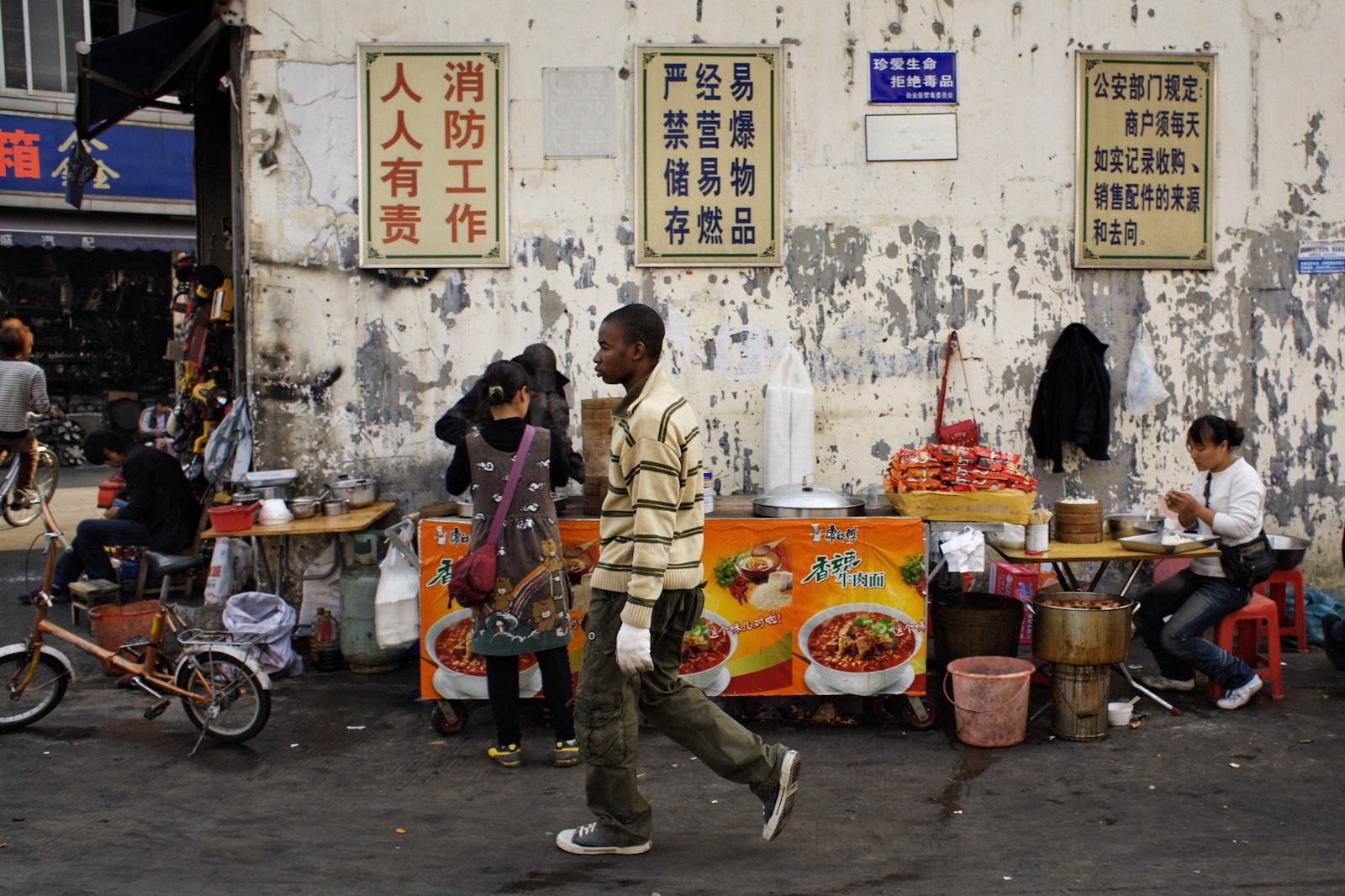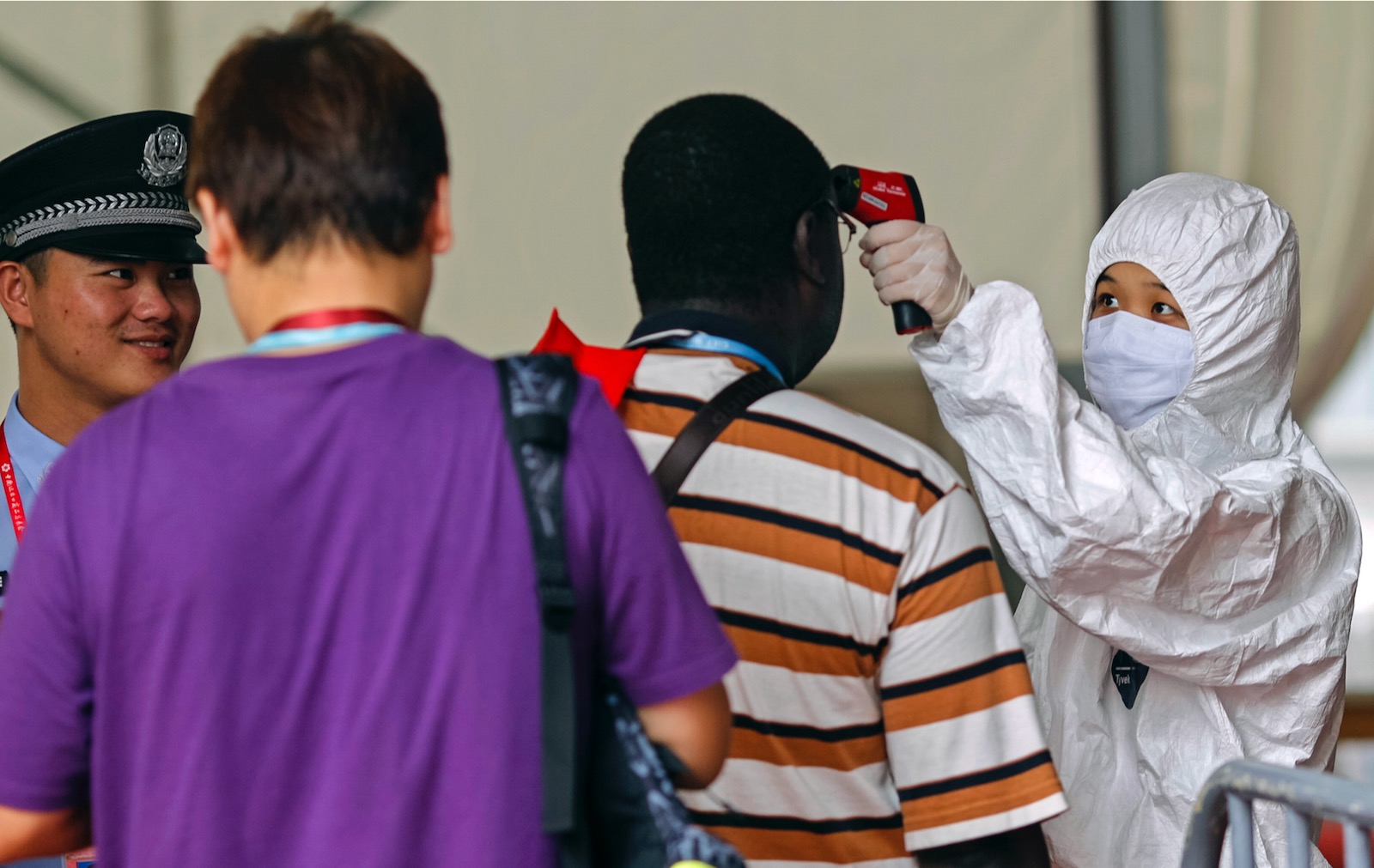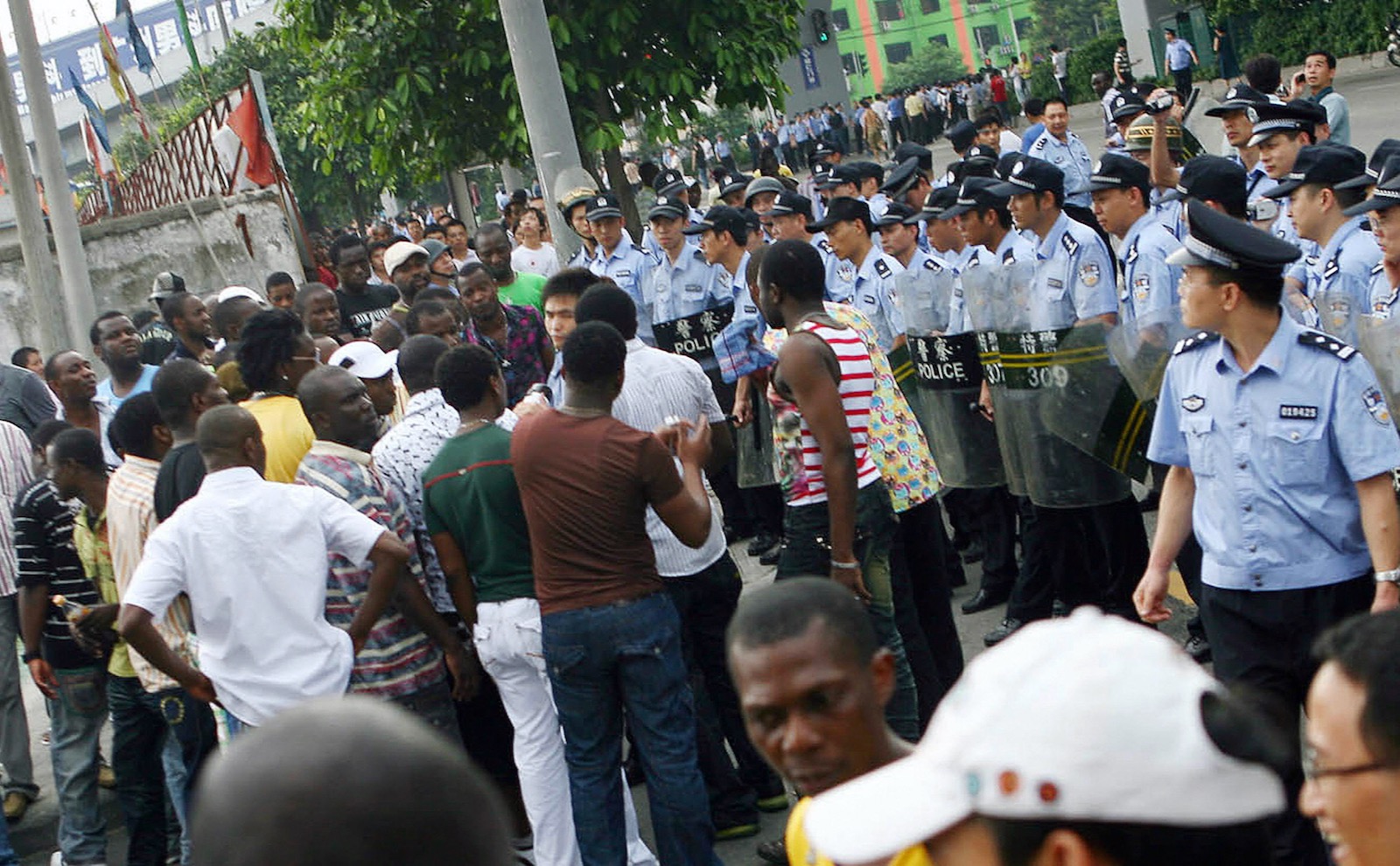In this pandemic, we have quickly become acquainted with a new form of witnessing, one that is both more collective and more remote than ever. From our various isolated “indoors,” blue LED screens have formed small portals into violence, beauty, tragedy, and nonsense. More than ever, we exist “in the discourse.”
The outbreak of Covid-19, the disease caused by the novel coronavirus SARS-CoV-2, began in Wuhan, the capital of Hubei Province, which ultimately suffered the highest toll in China—as of the end of April, more than 84,000 confirmed cases and 3,200 deaths—by a wide margin. The next highest number of cases has been 1,532, in Guangdong Province, of which Guangzhou is the capital.
Wuhan’s city-wide lockdown, which sealed off 11 million people from January 23, was finally lifted on April 7. For the entire month of April, China has reported no more than a hundred and fifteen new cases per day (with the exception of April 17, when 352 new cases were added by a review board that retroactively resolved duplicate and missing cases). But as the country cautiously transitions toward some semblance of normalcy, efforts to trace and control potential new outbreaks—like that in Heilongjiang Province, which prompted authorities to seal off the city of Mudanjiang and detain “any group of more than three people”—remain as stringent as ever.
By April 11, the authorities in Guangzhou had identified one hundred and nineteen “imported” cases of Covid-19, twelve of which concerned nationals of African countries. A cluster of local, non-imported infections in the city was traced to a single African restaurant. These incidents resulted in a severe crackdown, which may have led to an uneven and chaotic interpretation of official policies as the orders made their way down the bureaucracy.
One Togolese student was unable to find a place to stay when he was evicted after his university shut down campus housing. He took to sleeping under a bridge until he was chased away by police. A Nigerian student was given just hours to evacuate his apartment and forced into self-isolation at a designated quarantine hotel (often at the “guest’s” own cost) even after testing negative for Covid-19. Sectioned-off sidewalks were barred to Africans. A McDonald’s employee was pictured holding up a sign stating that the restaurant was no longer serving black people.
These and many other similar incidents captured on phone cameras traveled online across the world, along with a deluge of comments on Chinese social media justifying such actions and repeating racist stereotypes of Africans as “ungrateful” foreign migrants, carriers of disease, and criminal elements. Taken together, the experiences of Africans and the haunting chorus of racism suggest that this was about more than simply pandemic management.
The response from African states has been sharp and critical. The controversy was widely framed as a diplomatic catastrophe for the Chinese government, a “crisis in Sino-African relations” that threatened to undo all the goodwill that might have been cultivated through coronavirus-related donations that the Chinese government, along with Chinese companies and philanthropic organizations, had made to African countries over the past months. The official response of several Chinese embassies tried to remind African leaders of their countries’ “time-tested friendship,” and gave assurances that an investigation was underway. At the same time, Chinese diplomats advised their African counterparts not to let certain media outlets exaggerate the situation and “drive a wedge between China and Africa.”
These officials may have failed to understand how much of the controversy was driven by a surge of popular outrage and demands for accountability from netizens in Africa and the black diaspora. They also seem to have under-estimated the groundswell at home: even as the Chinese state appealed to Sino-African comity, a wave of nativist, anti-black rhetoric in China swept it away. In response to an address given by Foreign Ministry spokesman Zhao Lijian that was posted by the People’s Daily, the top online comments were overwhelmingly anti-immigrant and racist, many even criticizing the Chinese government explicitly for bending over backward to please foreigners. It was “a rare moment in China,” as journalist Tony Lin noted, “when nationalism lost, to racism.”
*
Censorship regimes with as much experience and sophistication as China understand the physics of discourse: they know how nationalism, like a flywheel, once set in motion, can generate great force and be difficult to stop. An information ecosystem “curated” by censors is inherently imbalanced: it is the distorted remnant after some things have been actively removed and others passively left intact. Content even remotely related to independent popular mobilization, say, is swiftly censored, while rhetoric that falls within the approved discourse—sometimes anodyne, but sometimes dangerous and hate-filled—is tolerated.
Advertisement
For example, Chinese authorities have left online anti-Muslim rhetoric largely unchecked for years, because building a narrative of separatist terrorism fomenting among the Muslim-dominant Uyghur population of northwest China helped to strengthen public support for greater surveillance and the notorious “re-education camps” in the province of Xinjiang. In 2017, a community of Hui—another predominantly Muslim ethnic minority—in Hefei province came forward with a proposal to rebuild the Nangang Mosque, a centerpiece of Hui culture and history first established in the 1780s. The new mosque was to be erected near a recently built, flashy condominium complex. However, opposition to the project from neighboring majority-Han people unleashed an online torrent of anti-Muslim hate speech, culminating in threats to desecrate the proposed site with a pig’s head and pigs’ blood.
This is how China’s censored discourse flywheel works. This nationalism—of which the particularly virulent online anti-black racism we’ve seen recently is a strain—though highly motivating and thus politically useful, once it gains momentum, is difficult to moderate. It is also a paradox of itself. Nationalists, argues Chenchen Zhang, an assistant professor of politics and international relations at Queen’s University Belfast, orient themselves in such diametric opposition to the West—here, they assign it the liberal values of the “white left,” or what those in the US might call the “libs”—that they end up employing much of the same language and ideas as right-wing populist movements of North America and Europe. The racism we see directed toward black people, immigrants, and Muslims, as well as the misogyny, that have their source in far-right Western groups, is replicated in the rhetoric of China’s digital nationalists.
No question, China has its own, specific history of racisms. But the modern form that Zhang highlights, which lives on the Internet, permitted in effect by the “nationalism filter” insofar as it is anti-Western, is distinct and new for how fast these images and words can travel. The sheer force of so many voices on so many portals, witnessing all at once, yet seeing different things, makes everything so much more flammable.
*
I have been to Guangzhou only once, for a brief few days five years ago. Like most people, I witnessed the recent photos and videos via my own quarantine portals—a laptop and a smartphone—from thousands of miles away, in Nairobi, Kenya. Here, I am a part of a Chinese diaspora in East Africa—a mirror-image of the Africans in Guangzhou.
I watched what unfolded in Guangzhou with a multilayered discomfort, that familiar progression of powerlessness, vulnerability, and complicity. First, a secondhand anxiety and firsthand shame at how blatant and unapologetic these acts of racism were. Second, a knot of dread: knowing that the tragedies unfolding in Guangzhou would inevitably manifest, through the zero-sum logic of identity politics, as a backlash against Chinese people living in Kenya. And then, finally, a discomfort about that discomfort, knowing that being called a “chink” cannot possibly compare to being forced to pack my bags, put on a mask, and sleep under a bridge. Being a member of a diaspora often feels like a form of conscription.
Knowing how little I understood about this city I was watching from afar, I embarked on a process to understand “Little Africa,” as Guangzhou is sometimes known—not Guangzhou writ large, but specifically the city’s relationship with its African diaspora, which is the largest in China. I learned that we must begin to speak of “Little Africa” in the past tense. The official number of Africans in Guangzhou—though, arguably, a vast underestimate, since it doesn’t take undocumented migrants into account—has plummeted from 16,000 in 2014 to 4,500 this year. Whatever “Little Africa” used to be, it is not anymore. But as I read descriptions, watched documentaries and movies, dug up images of what “Little Africa” used to look like, it became clear to me that much more has been lost, beyond the numbered population. I had not expected the research process to feel like mourning.
One of my favorite videos was a seven-minute, uncut introduction to a documentary from 2014, posted by Roberto Castillo, a professor of cultural studies at Lingnan University who studies race and China–Africa relations. He is filmed walking at night through a single stretch of open market in Dengfeng, part of Yuexiu District where many Africans lived and worked, as well as where some of the recent videos were taken. The neon-pink fluorescents and backlit red awnings harmonize with what I imagine to be the warm, humid air of tropical Guangdong.
Advertisement
Fruit stands, clothes racks, and suitcases spill into the walkway, and as Castillo walks, mostly wordlessly, the people passing by form a stunning carousel of humanity: a Muslim Chinese woman in a pink silk, sequined hijab; an African man in a long, sand-toned kaftan; two professorial black men in loose, silk shirts; right behind them, a young black man wearing a glitzy cap; a bearded white man clutching his backpack; a Uyghur man brushing sauce or oil on a row of charred tilapia, while an African man waits for his fish. (Castillo stops to point out that tilapia, grilled whole like this, is an “African” preference; many Uyghurs started serving fish and chicken “African-style” in the past few years.) Castillo’s video captures a collage of voices: many “broken” Englishes, Putonghua with a Guangdong accent, a “salaam aleikum,” a mother yelling at child, and many other languages that I do not understand.
Dengfeng, like other districts in Guangzhou where African migrants and those from other parts of China, often ethnic minorities, mingled, was a sociologist’s paradise: an intricate ecosystem totally indifferent to its own diversity. It was driven not by any extraneous force or overarching “mission,” but rather by the complicated, imperfect, almost molecular human forces of profit-seeking, love, pride, boredom, curiosity, self-actualization, escape.
Of course, there was nothing romantic about “Little Africa.” Guangzhou was, and is, quite literally, a place where outsiders are not allowed to belong. China is not a country of immigrants. Compared to North America and Europe, where international migrants often make up 10–30 percent of a country’s total population, the figure in China remains at only a tenth of a percentage point, lower even than North Korea’s. There are comparatively fewer pathways for work permits, permanent residence, and naturalization than in other countries. (Only 7,356 permanent residence cards were issued between 2004 and 2014.) In 2012, with the passage of the Exit–Entry Administration Law, which mandated detention for up to sixty days for those caught working or staying illicitly, along with a steep increase of fines, life in Guangzhou became more perilous for many African migrants.
Some more vulnerable foreigners, especially those from the global South, who often set out on their own, with little formal support or safety nets, found themselves with no choice but to overstay their visas and slip into an undocumented life. (Castillo writes that these people will face incredible hardships in the coming months, as China’s deployment of its tightening system of bio-surveillance to manage the transition into post-epidemic life becomes the norm.)
Any sense of belonging or home that Africans had been able to carve out in Guangzhou—whether through networks and shared spaces with other Africans or by integrating into Chinese society—existed in spite of these circumstances. For many, the city offered only a veneer of cosmopolitan hospitality.
The conditionality and fragility of these marginalized people’s place in Guangzhou was always an inescapable reality. We are reminded of this when we see those photos of young black men, face masks on, standing with their packed belongings out on the street. There is a special horror in facing humiliation and ostracization as a vulnerable minority, far from home.
*
Guangzhou remains, by Chinese standards, an outward-facing city that offers opportunities to both international and Chinese migrants, which is why many risk it all to go there. Dengfeng and others were places where a plurality of identities—not just “Chinese” or “African,” but Hui, Igbo, Pentecostal, atheist, biology student, villager, entrepreneur, undocumented person, lover, matriarch—could interact in unpredictable ways that defied the unified message of officially sanctioned nationalism. But last month, a draft revision of regulations that would broaden the criteria for foreigners to obtain permanent residency sparked a sharp racist backlash on Chinese social media.
“In a hundred years’ time, I don’t want China to have become like the US, with all kinds of people mixed together,” wrote a Weibo user, cited by the online magazine SixthTone, in a post that received over 22,000 likes. “We Chinese people have a strong national sentiment. We have the same ancestors, we’re all children of the Yellow Emperor, the same blood courses through our veins.”
Amartya Sen wrote in his 2006 book Identity and Violence that the counter to identity-based conflict is not “We are all the same,” but rather, “We are diversely different.” The reduction of humans to a single identity, he writes, not only makes the world more volatile, but is too easily beholden to power. Who gets to control which single identity “matters,” takes primacy over all the rest, whether or not the individual even identifies with it?
China is projecting broad messages of co-operation, especially in service of the Belt and Road Initiative. But these paradoxical forces—one outward-facing and positive, the other inward-facing and negative—will surely work against each other. The indifferent plurality of Guangzhou called the bluff of so-called China–Africa “peace programs.” These well-intentioned aims to “bridge the gap” between Africans and Chinese are still predicated on the notion that, among our various identities, “Chinese” or “African” naturally takes primacy. Such binary ways of imagining China’s and Africa’s shared future serve only to maintain the tensions in this relationship just below flash-point, ready to be ignited by the next video. The binary also contains its own asymmetry: Why does immigration only get to flow in one direction? How is it that the Chinese diaspora flourishes openly in Africa—according to one study, there are more than 40,000 Chinese nationals in Kenya alone—but in China, Africans are met with violent dehumanization?
Today, the flywheel has gained inertia. The Chinese diplomatic community’s attempts to assure African governments of goodwill, to pin blame on Western media, have failed to paper over the racist, anti-immigrant invective on Chinese social media, exposing how potent nativist ideas are, once set in motion. The human wounds of humiliation, ostracization, and hatred will endure longer than the official communiqués.
Ultimately, though, all of these narratives—whether the global glory of the Belt and Road, or nationalists’ imagined “pure” China, or even the destiny of Sino–African friendship—promise some form of inevitability. “Little Africa,” a fragile ecosystem of the margins, was the opposite of inevitability. That window to a more complicated, ungovernable shared future for Chinese and Africans—one that, right now, we might not even be able to visualize—is closing. The warm pink lights of Dengfeng’s night-market have faded from the blue screen of my phone.




